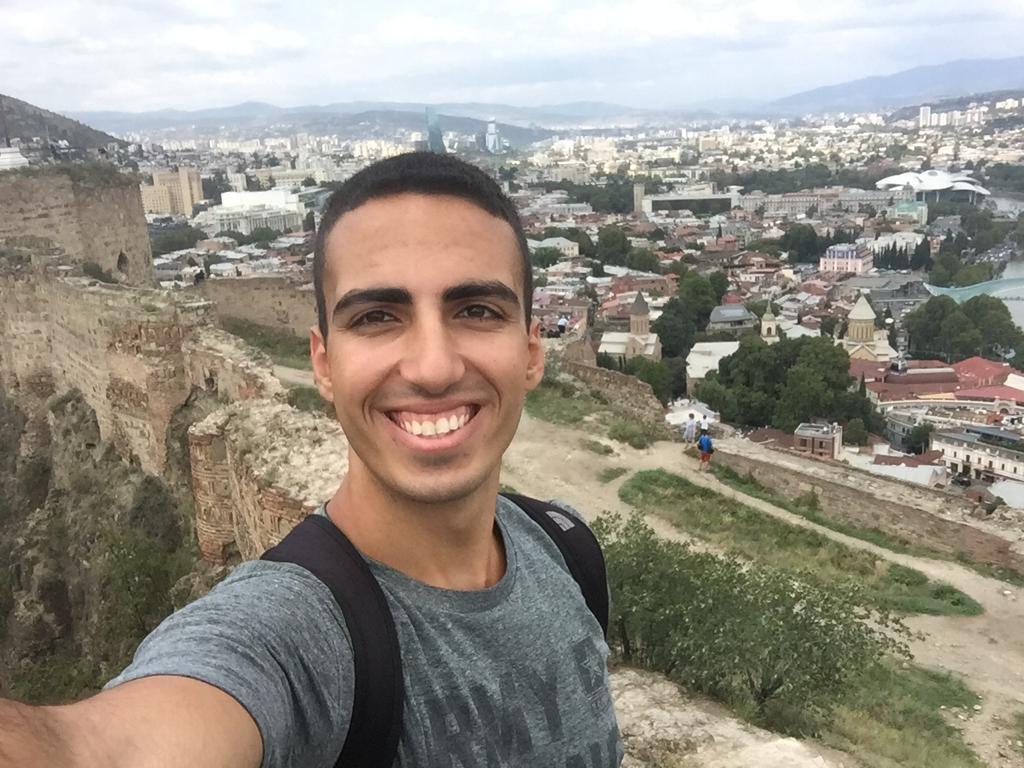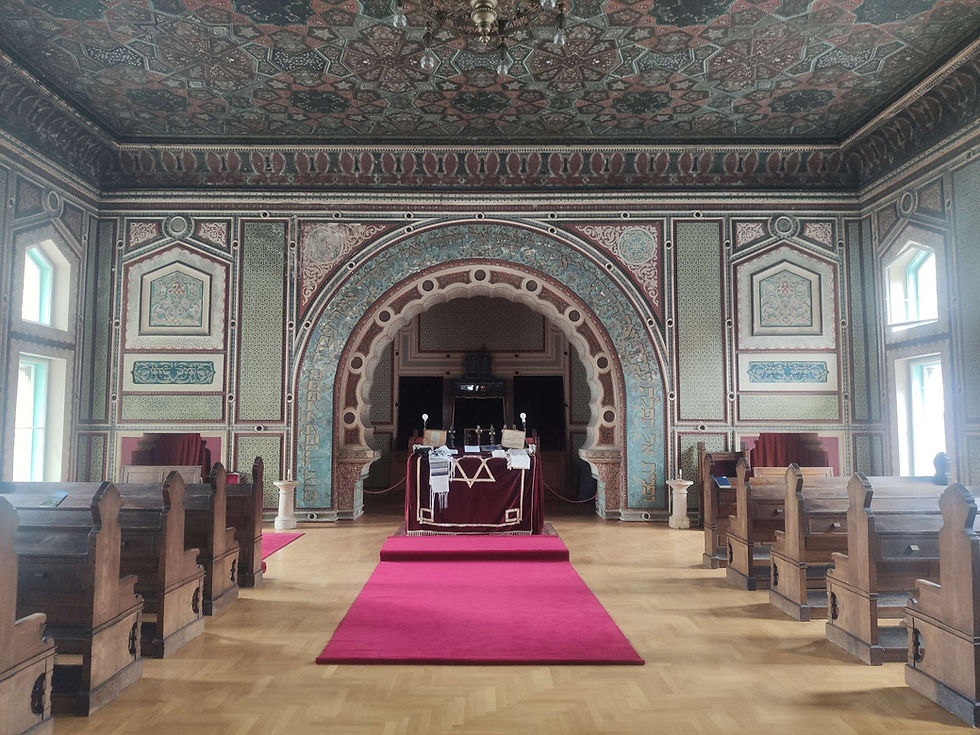Sarajevo: Welcome to the Balkans
- Aaron Schorr

- Jul 2, 2023
- 8 min read
Yet again, I was woken from my nap by the plane hitting the tarmac, none too softly. From the ramp, Sarajevo looked like an overgrown Austrian town - a gray drizzle falling over steep green hills all around. This was a flight from Istanbul, and the passengers were practically climbing over each other to get off first. The joke was on all of us, since we were herded into buses to drive literally less than 200 feet to passport control.
In the Istanbul airport, I had reunited with Yotam (of Japanese, Taiwanese, Russian, Turkish, Moldovan, and Ukrainian fame on this blog). Our taxi driver was practically bursting with excitement, and tried slamming the passenger door by sharply accelerating out of the taxi stand. The excitement increased when we told him we were Israeli - "long time ago, many yevreii people live in Sarajevo!" He was quick to point out the bullet holes visible in the buildings around us, and told us he had served four years in the Bosnian army during the war in his late twenties. "Many of my friends dead, many children dead."
The conversation shifted to the present. His son had left Bosnia seven years ago for England - "like most people." "He says I no want to make €1000 a month, I want €2000 a month!" He said it lightheartedly, but the numbers are terrifying. Bosnia today has the same population it had in 1960 (3.27 million), down almost a quarter from its postwar level. The second-largest Bosnian city, as we were about to learn, was Stuttgart.
Had we had dinner? The recommendations came fast and hard. "Bosnia food very beautiful, many young people like meat." In hindsight, this was the canary in the coal mine for my diet over the following two weeks. The national dish was ćevapi, grilled kebabs served with raw onions and flatbread. "Very beautiful!" My familiarity with this dish was from this canonical Key and Peele sketch, which was honestly a great primer for a Balkans trip. Both hands were off the steering wheel at this point, looking up photos of Bosnian food to whet our appetites. He wasn't wrong, however, and the grilled meat in Sarajevo was some of the best we were to have in the Balkans.
Our group grew yet again when we found Richard (of Indian and Thai fame on this blog) and went on a walking tour of the old city. The cafés were full to capacity with people drinking coffee from small copper cups called fildžani. To my untrained eye, it looked like Turkish coffee, but that was of course a major faux pas since there was a minor difference in the preparation technique. Bosnians drink five or six of these a day, taking about two hours in total because they typically require several cigarettes each. "We are not the most productive people," the guide conceded.
Sarajevo used to be a major artisanal center, of which only the coppersmith street remains. The reason for both the disappearance of the other artisans and the endurance of the coppersmiths is the same - the war in the 1990s. The city was besieged by Yugoslav-Serbian forces from April 1992 to February 1996 - a year longer than Leningrad and one of the longest sieges in modern history. The human toll is well captured at the Museum of War Crimes. Over these 44 months, hundreds of thousands of bullets and shells were fired at the city, which were then collected by enterprising locals after the war. The bullets are turned into pens, bottle openers, and little tanks and airplanes; the shells have lead poured into them and are turned into decorated vases.
At the edges of multiple empires, Sarajevo had been known as the "Jerusalem of Europe." Under both Christian and Muslim rule, the city was a haven of religious tolerance and members of different faiths lived in mixed neighborhoods for centuries. When the Austrians arrived in the 19th century, they built a brewery halfway between a major church and a mosque. It's a vast complex, with a visitors' center decorated in the heavy Austro-Hungarian style that would feel at home in Prague or Budapest. Fresh off the boat from Morocco, I naively asked whether beer wasn't haram. "Beer is a vitamin," was the response. "But we prefer rakija in Bosnia, and that's an antibiotic."
By this point, we had arrived at city hall, a beautiful neo-Moorish building commissioned by the Habsburgs by the river. It was then converted to a library by the Communists, destroyed in the war, and rebuilt in the original design two decades ago. Just to the west is the spot where Franz Ferdinand was assassinated in 1914, sparking the First World War. Originally, the site was marked by a plaque condemning the assassination as a cowardly act of terrorism. To Yugoslav patriots, however, Gavrilo Princip was a hero, and the assassination was ultimately a great triumph, leading to formation of the first pan-Slavic Balkan state in 1918. Yugoslav authorities (both royal and communist) thus maintained the site as one of patriotic heroism. The contemporary Bosnian government is much more conflicted about this history, and the current plaque is terse and purely descriptive.
This was the perfect segue into Bosnian politics, which are uniquely complex and frustrating. After an independence referendum in March 1992, the new state of Bosnia and Herzegovina plunged into war against Serbian and Croatian forces (both regular and irregular). Three years of brutal fighting eventually culminated in an American-brokered peace agreement known as the Dayton Accords. Under the agreement, Bosnia was divided into two states - the Federation of Bosnia and Herzegovina (a majority Bosniak state with a Croat minority) in the west and the Republika Srpska (literally, "Serbian Republic", a majority Serb state) in the east. To make it more difficult for the latter state to secede and be absorbed by Serbia, its territory was broken up, with the small district of Brčko acting as a UN-administered wedge between the two sides. The border between the two states runs right through Sarajevo, tracing the front lines from 1995. Today, then, Bosnia has three presidents, three parliaments, and 72 political parties. Some decisions require unanimity, leading, predictably, to polarization, paralysis, and dysfuction.
Here, then, was the painful paradox of Sarajevo: a legacy of religious tolerance pushing up against a recent history of brutal sectarian violence. Within five minutes of walking from our hostel, we could reach a mosque, a synagogue, and both Orthodox and Catholic churches. All four still had visible bullet holes.
The synagogue was predictably of particular interest to me, as Sarajevo has a unique Jewish history. At the western edge of the Ottoman empire, the city was the destination of many Jews expelled from Spain and Portugal in the 16th century who at one point constituted almost one quarter of the city's population. For four hundred years, the Jews lived in harmony with their neighbors, until the Axis invasion of Yugoslavia in 1941. Sarajevo fell to the fascist Ustaše, and 85% of the community was killed in the subsequent years. Interestingly, the initial immigrants had brought the original Passover Haggadah with them from Spain. During WWII, it was hidden in a mosque's library, and then in the national museum vault during the wars of independence. It is still in the national museum, but we didn't get a chance to see it.
Today, there is only one synagogue in operation in Sarajevo. After the horrors of the 1940s, religion was then suppressed by the Communist authorities, and many Bosnian Jews only discovered their religious heritage when their ancestors died. As a result, very few people can read Hebrew, and the prayer books have both a translation and a transliteration into Bosnian. The ground level of the building was destroyed in WWII, but the upper levels were rebuilt in a unique Moorish style to serve both the Sephardic and Ashkenazi (Austrian) communities.

The other interesting site of historical memory is the War Childhood Museum, which unlike other museums does not try to shock its visitors. Instead, locals who had spent their childhoods in the besieged city were invited to donate an item to the museum which symbolized their experiences. There were beautiful narratives of pain and perseverance, and more modern objects donated by children in Gaza and Crimea. The thing that hit me most was a wall covered with food packages that arrived in Sarajevo as humanitarian aid. Nestlé crackers, Barilla pasta, Gösser beer - the familiarity of the items really drove home just how recent the war was. Only 30 years later, the streets of Sarajevo were now filled with unarmed middle-aged soldiers drinking coffee on a Monday afternoon.
Sarajevo wasn't all politics and memory, however. Above the brewery is a cable car that runs up to the Trebević mountains. The distance from the city center through hillside neighborhoods with vegetable gardens to the fantastically green mountains above is only about a kilometer, which enhances the feeling of being in an overgrown Alpine village. We met up with Lucia, a friend from Yale who was spending the summer in town, and walked through lush meadows. It was a serene place, save for the local teenagers in punk outfits playing Slavic beats. Sarajevo hosted the 1984 Winter Olympics, and the bobsled track was built on Trebević. It's been left to rot and makes for a great adult playground almost 40 years later. Closer to town is a similarly abandoned Yugoslav military headquarters with trees growing in the courtyards and elevator shafts. It reminded me of Abkhazia, except it actually had a wall around it.
In need of a break from war crimes and childhoods, we found a lovely little tea shop that seemed to embody Bosnia’s identity as a crossroads of culture. The owner handed us a bowl of cherries he had picked the same morning, and I indulged my curiosity about the local version of Moroccan mint tea. It was a small place, and there was a rather unique-looking man rocking the owner’s infant child. He was wearing a cropped tank top that showed his tattooed chest and arms - the former covered in Allah’s names in Arabic, the latter in Hebrew angel names. Wearing steampunk sunglasses indoors, his head was wrapped in a black turban and culminated in a pointy black beard. He caught me trying to read his chest and we struck up a conversation. I mentioned I was Israeli, and he started gushing about how much he loved Tel Aviv. “They were very confused in the airport, though.” I laughed. He was a jazz musician, and we swapped notes on trumpeters we found transcendental. I cautiously tried making a comparison between the complicated sectarian politics in our birthplaces, and he nodded thoughtfully. “Others cannot understand this.”
Lucia said she knew a spot for live music, and we set out to find her. We accidentally stumbled into a restaurant kitchen, but eventually found the place - a converted Communist movie theater, complete with chandeliers and a projection booth. The very brusque waiter sat us at a table at an absurd incline near the back and handed us shots of what tasted like cherry-flavored cough syrup. The band struck up what must have been Bosnian classics, since the crowd all started singing along with the accordion and guitar. It was a wonderful place, but a much less wonderful reminder of life before indoor smoking bans. Literally every table had at least one lit cigarette at any given moment, creating a smoke cloud so thick that tears were literally falling from my eyes by the end. Welcome to the Balkans, right?



































Commentaires